Hot Glass Bits #36
Contact Mike Firth
February 23 to July 7, 1997
[Images added in 2003 from GAS 97 pages]
This issue contains the following date/deadlines.
GlassWeekend '97, Wheaton Village NJ June 13-15,
1997
HOW TO DESIGN YOUR
CAREER PATH, lower registration, 7/31/97
CREATIVE GLASS CENTER
OF AMERICA, application deadline 9/2/97
[capitalized KEYWORD starts a paragraph below]
Hot Glass Bits is a personal chronological record of
my wanderings through glassblowing and the bits and pieces of
knowledge I gather along the way. It includes things I try,
thoughts I have, information I receive, and reports on things I
do. In many ways it is an edited diary and events calendar about
glassblowing. If it is useful to others, it is worth the effort.
It is normally closed near the end of the odd numbered months and
mailed soon after. WHOAMI? - Mike Firth is a 54 year old, low
experience glassblower who signed up for his first class in '91
without having seen anyone blow, although he had seen TV shows,
and had done stained glass and worked clear tubing in the past.
He has built cheap equipment in his back yard to learn and
practice and is now on his second round, more traditional, of
equipment. When not blowing, he is a married employee of the best
hardware store around. Vision Thing: Working glass from a furnace
can cost a small fortune, it would be useful to have a package of
equipment that is straight forward to build and not very
expensive. The legal stuff: Working glass is inherently
dangerous, involving heavy materials that can be razor sharp, so
hot that damage can be done before feeling occurs, with chemicals
immediately poisonous, dusts that can damage the lungs, and heat
sources that can wreck the eyes. Understand the safe practices
required and use them to blow beautiful glass.
If I could, I surely would spend the week of July 12-18 at
Hands-on Glass (see below) for a weekend of Murrini and a week of
Flame & Furnace.
No, you probably didn't miss an issue.
Yes, I have included 3 1/2 months in this issue, having put
the last one out late and having had too much fatigue, too little
time, and too much to do since the last issue and getting back
from GAS 97. That is part of the reason that subscriptions run
for a year and not for a specific number of issues - and also why
I am casual.
Pictures on the web If you have web access, my web page has
pictures from the GAS 97 Conference that relate to the content of
this issue. See the URL above to track me down.
INTERNET - If you are interested in
exploring the Internet for glass, this site: http://www.siu.edu/~siuglass/
which is the Southern Illinois University glass studio, has a
well maintained list of links to other sites.
NEW RATE - Hot Glass Bits has been available by snail
mail or in text, htm, or eps versions via e-mail. Subscription
rates via US first class mail are $15 per year, add extra postage
for other countries. Starting with HB35 issue, I will be offering
a lower e-mail rate for files that I can reasonably create (those
listed above plus MS Works, MS Write, MS Word, Word Perfect, and
RTF) sent anywhere in the world. The new rate will be $12/year. A
land mail address or phone number will still be required because
of the disappearance and changes of e-mail services. 1/30/97
HORIZONS, The New England Craft
Program [108 North Main St. Sunderland MA 01375, 415-665-0300,
FAX:413-665-4141] offers Late Summer Intensives (Aug.7-10)
include Glassblowing, 6 days August 4-12 with an optional 4 day
add-on Aug.13-16 and Lampworking: Shaping Glass in the Flame with
Bandhu Scott Dunham. 1/16/97 6/29/97 Fall Foliage Intensives are
Oct. 12-14 and include Glassblowing, Focusing In with Jim Holmes
($310+lab fee), more advanced techniques for people with prior
glass experience and Glass Beadmaking with Raven Wilson.($255+lab
fee) 7/6/97
HUGE GAP - Here it is more than a third
of the way into March and I have reported on almost nothing
related to glass. There has been a lot of activity on the
Internet to occupy my spare moments and planning for the G.A.S.
Trip, but most of my time has been juggling rainy days against
trying to get enough time to pickup the replacement tree for the
front yard and rent the trencher to install it, lighting and
water for it and wiring for the garage and for a glass
workstation in the back yard. I finally did it last weekend,
exhausting myself with the bucking (and not to sharp) trencher
and adding to my problems by hitting the water line and having to
repair it. If the water line is not leaking, the water table is
about 10 inches below ground level right now. In conduits, so I
can add more later, I am running 40 amp 220 volt service and
multiwire signal plus natural gas piping to the garage and the
work station. Of course, with costs of the G.A.S. trip and the
costs of this (minus the $350 the guy who hit the tree paid) I
will not be able to spend anything too serious additional on
glass for a while. 3/12/97
Subj: Stuff Date: 97-03-14 22:19:39 EST From: hultman@ix.netcom.com
(Lori or Jeff Hultman)
Hi--I haven't had time to write in awhile, mostly due to family
stuff. I wanted to let you know that I loved the class at Corning.
The facilities there are beautiful. The studio itself is so quiet
and clean and the tools and all the equipment just looks and IS
so professional. The furnace was 1000 pounds I think and there
was also a 2nd furnace with two crucibles of color. They had
three annealers, a pick up oven, a garage, hmmm I can't think of
anything else, but it seemed like they had everything. They also
had lockers for us to use which I was a luxury I never
experienced. The only thing missing was a store to buy color or
any other tools or supplies you might want to get. But, that also
saved me lots of money I didn't need to spend. They keep the
place meticulous and it is very comfortable to work in. The staff
was also pretty helpful and the meals and accommodations were good
too.
The structure of the class was pretty loose, but allowed
working time pretty much from 9 am to 11pm. Jack Wax was the
instructor and his teaching style was great for me. He gave so
much individual attention to everyone, making everyone feel his
or her work was especially important. We worked at our own pace
without feeling pressured or judged. Egos were checked at the
door too. Having the museum there was fabulous and their library
is incredible. You could spend a week there just doing the museum
and library. They have all kinds of books, magazines, videos,
slides, EVERYTHING YOU EVER WANTED TO KNOW ABOUT GLASS!!! The
major disappointment was that the time was too short, and I would
have stayed a few more days if I had known more to begin with.
The second disappointment was a 'tour' of the Steuben factory and
I thought that was pretty much a waste. Maybe it was the time of
year or the time of day even (near the end of the shift), but it
seemed like the men who worked there were excellent candidates
for people arguing that labor unions make people lazy. I don't
need to say any more.
All in all, I have to say it was a rewarding experience and a
great value for the money. I hope you get to go some time. I hope
everything else is good with you. I still have actually starting
building our hot shop. I have to take the dog out right now, so
I'll write again soon.
Lori Hultman Subj: Austin Glassblowers Date: 97-03-21 08:09:40
EST From: NCFVF 1 To: MikeFirth
Dear Mike:
I went to Fire Island Glass while in Austin. Matt and ?Teresa?
were great to talk with and gave me a couple of referrals for
equipment/supplies. I did not get down to Wimberly.
It's a small world, to resurrect a cliché - Teresa told me there
was another glass studio in the area; in fact it turned out to be
in Spicewood with an Austin phone and was a woman (from Detroit
who married a Texan) with whom I did a concentration at Penland
in 1994: Marty Johnson, ZERO Gravity Glass Studio, 25418 River
Road, Spicewood, TX 78669; [now closed]. I went out to visit and
take pictures of studio equipment - I hope they turn out good.
Mart's glass studio and her husband's metal studio next to it are
wonderful - they are on the bank overlooking the Perdenales River.
They also are building a great house next door.
I also saw some good movies and documentaries while at SXSW Film
Festival. A documentary on Robert Johnson: "Can't You Hear
the Wind Howl?" was terrific, especially for any who loves
the blues.
The Texas Memorial Museum at UT had a spectacular extensive
permanent collection exhibit of Pre-Columbian pots - I took lots
of pictures and hope they turn out good also. Also, I took pix of
the large animal paleontological exhibit - most of the fossils,
vertebrate and invertebrate, had been found in TX.
I had some good Vietnamese food while in Austin and some great
TexMex, especially at Chuy's. Also, I went to the original
Threadgill's - down home TX country cooking. Threadgill's was not
as good as anticipated but the place was fun.
My husband, Carl, and I applied to The Studio at Corning for
Gudenrath's class in June - we're keeping our fingers crossed. (Matt
and Teresa also have applied to the Studio this summer -
apparently they went last summer.) I look forward to your notes
on the Tucson GAS. Best of all possibles...Marjorie
BACK FROM G.A.S. - As I write this over a week has passed
since I was in Arizona. The G.A.S. Conference was very good, with
some high points unlike other conferences. I have a lot of
material and this issue is already so late, I am wondering if I
will be able to catch up with later issues when there is less
material coming in. What were some of the highlights?
I started the week's visit with a trip
to the University of Arizona Mirror Lab, which was neat to
see and fit in with the theme of warm glass of the conference.
The Lab is making huge astronomical mirrors - 5 to 8 meters (about
16 to 26 feet - 200 to 300 inches) - using a mold that spins at 7
rpm. This spin would give a curve to the molten top surface.
Cores to give the back a honeycomb structure are computer carved
on top to match the curve of the mirror. Chunks of glass, 37,000
pounds, are placed on the cores which surrounded by heating
elements and covered with a lid with more elements, using in
total a million watts. The spin and the core shape produce a thin
(1-2") layer of glass with the honeycomb structure behind,
so the blank is much lighter than that produced at Corning by
pouring molten glass over cores, taking much less time to anneal
and having much less glass to be removed for a perfect surface. (Bubbles
are fixed by grinding them open and inserting halves of sized
glass beads.) The honeycomb will be fitted with ventilation
plumbing to adapt the glass to air temperature rapidly and to
actually change the curve by heating and cooling selectively.
At the time we visited, they were working to rescue a casting
that leaked several thousand pounds of glass below the cores. The
cracks are now sealed with cold glass and a too thin layer of
glass is across the top. They are cleaning the top surface and
intend to melt a new layer of glass on the top, keeping the sides
at the annealing point and bringing the top quickly up to the
melting point, with frax blanket separating the temperature areas.
The scale of the place is impressive, it takes a lot of
equipment to melt, grind and move a chunk of glass 25 feet across.
Heavy steel rings and frames form carriers and mounts. A major
event of the middle of the Conference was the Calido, the opening
of a major show of "warm" glass at the Tucson Museum of
Art. The museum is built on a very small footprint in a historic
district by spiraling down into the ground with an elevator at
the bottom that brings you back to the outside of the museum. The
show includes extraordinary examples virtually every method of
working glass above room temperature and below furnace
temperature, including sagging 1" x 4' x 8' sheets, dichroic
films that reflect a different color than they transmit, casting,
fusing, pate de verre, and so on. Although nothing made me want
to change from furnace work, some of the more striking pieces
were by Richard LaLonde (which I also encountered at a gallery)
who fused very bright opaque color powders to clear and then sags
to a vase shape. Karen LeMonte dragged and modified hot bottles
into the shape of clothing. Sidney Cash fused a piece that
appeared to be thin ribbons flowing and folding from a sagged
layer holding three wires; the ribbons hold the resulting
structure. Mary Shaffer had an installation "Tool Wall"
with glass sagged across and round tools such as hooks, clamps,
and wheels; some of the displayed pieces had the glass going up,
for a disconcerting variation.
MELTDOWN GLASS - Appropriately,
the last thing I did on my trip was to visit B.J.Katz at Meltdown
Glass Studio in Scottsdale [1-800-845-6221] who does fusing and
slumping and has equipment to do it on a grand scale. Her largest
kiln takes over 60 amps of 3 phase at full power and gives her
over 5 feet by 10 feet inside. It is a large flat heavily
insulated box that is lifted by a chain hoist off a table that
rolls to the side, the whole built in place by her and her
friends. Besides using it to do large pieces, when she was
invited to produce for the museum 250 pieces in a limited series,
she put dozens of molds in the kiln and fired them all together.
Her major activity now is seashore pieces with color elements of
reefs, fish and coral on bowl shapes. During and after the
conference there were many interesting furnace related events.
FURNACE - The one that may have the most
influence on me was a three hour session on building a studio,
which focused on furnace making by John Chiles [P.O.Box 164,
Weston VT 05161, 802-824-4415], a guy who will build you furnace
($6,000 in materials, $7,000 in labor) or rent you the forms to
cast your own ($400 plus shipping.) He made a convincing case for
down draft furnaces with freestanding pots and lots of
insulation, so much so that I am going to modify the dome I have
to cast to perform that way: burner above the pot, aimed across
its back edge, gas spiraling to a flue below the pot rising
behind the furnace.
He made the best case against invested pots I have encountered.
The advantages of invested pots are that they reduce the risks of
stressing the pot during heating and cooling and when (not if)
the pot cracks, the investment permits longer use by catching the
glass. But investment restricts the amount of insulation that can
be put around the pot (because adding insulation changes the
temperature curve in the investment so the glass can flow further
into the insulation and thus reduce the insulation value.) But
the price of using the cracked pot is that every time the glass
in the pot gets low, some portion of the glass in the investment
flows back into the pot, producing chords and bringing trash with
it.
ELECTRIC FURNACE - I got to see
a successful electric furnace at Chuck Willoughby's Canyon
Studios in Prescott [520-776-4002]. It was designed (and built?)
by Jim Moore who makes nice tools in the Seattle area. The heat
source is silicon carbide rods off three phase power and provides
enough heat to melt Spruce Pine batch. The furnace is a box with
thick insulation. Access is provided by pneumatically moving the
thick box-like top - first the rails supporting the top are
raised about 2 inches then the box slides back. A shelf with an
oval hole is pulled back along with the box and provides
protected access to the pot. It's all triggered with a foot
switch. So are the doors on the glory hole - with a pair of
teardrop shaped holes - and a reducing atmosphere valve that adds
more gas.
JOHN POWELL blew the first demo that I
saw at Philabaum's and it was most impressive seeing the piece
being made. Powell makes the bags with the stained glass colors
that stand about 3 feet tall. The techniques are straight forward
if large. Two and three layer cane is pulled to large diameters (3/8"
to 1"), sheared to about 1/2" pieces and laid out in
rows on a marver table. This is heated with a torch nearly to the
melting point. The parison is worked out on the pipe to give the
right diameter to roll once across the colors. A last very hot
gather is made, draining the excess, and the 4-5" bubble is
rolled on the marver and rushed to the glory hole melt the glass
in. When all the colors are hot, the exterior is worked somewhat
and the size increased. A platform on a table has been prepared
and Powell runs up to the top and begins blowing the piece down
between a V of large (2-3") pipes welded to a plate. A guide
at ground level keeps him informed so he can lift the piece up to
avoid sticking to the pipe and blow the piece out to form a nice
bottom to sit on. The top is hit with torches and stretched to a
foot or more and the neck is cut with pipe cutter more commonly
used on 3-4 inch copper. A man in a silver space suit carries it
to the annealer.
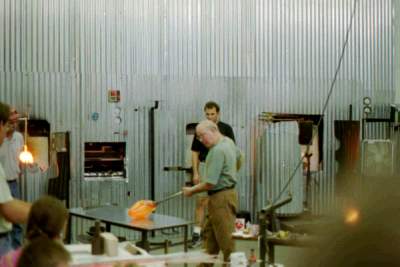 LINO TAGLIAPIETRA blew two
demonstrations on Saturday morning, a hot ticket that caused some
problems with people who had registered very early in expectation
of being certain of getting in. I saw the first demo. Within the
limits of my notes and memory, this is what he did. [2003 - I don't have
pictures of the early part of the demo because the film was slipping in my
camera, making a multiple image.]
LINO TAGLIAPIETRA blew two
demonstrations on Saturday morning, a hot ticket that caused some
problems with people who had registered very early in expectation
of being certain of getting in. I saw the first demo. Within the
limits of my notes and memory, this is what he did. [2003 - I don't have
pictures of the early part of the demo because the film was slipping in my
camera, making a multiple image.]
A steel plate covered with kiln wash was placed on a long handled
tool with another plate and heated in the glory hole.
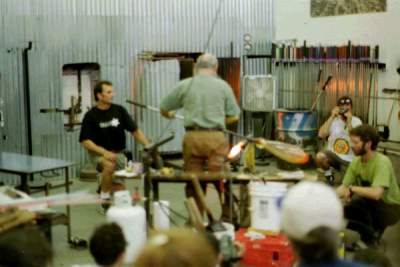
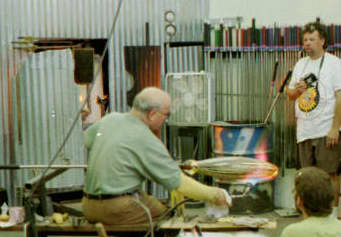
Upon removal, large (1/4") clear encased opaque stringer was
laid on it with steel blocks at each end to keep it from rolling.
Reheat.
On a gather large enough that the stringer will not go all the
way around, pick up the stringer, leaving a gap.
Jack the gather and pull the tip, cutting off extra, so the
stringer lines run from one end to the other.
LESSON: Wasting glass is a constructive
technique.
Bow the piece, while puffing, to make an inflated new moon shape
with the clear section outside.
Punty the piece on the outside of the bow. Heat especially the
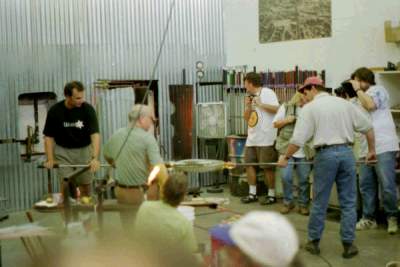 inside of the bow and punty to it with a hot gather so that the
center can be pulled into a third point even with the two ends.
inside of the bow and punty to it with a hot gather so that the
center can be pulled into a third point even with the two ends.
Reheat the three tips and pull and cut the tips until able to
pull the edges out to make a bowl shape with curved lines running
around the body of the bowl.
LESSON: A wet cloth draped over the hand
protects up close while shearing large glass.
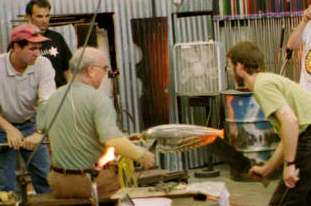 Gather on a pipe, burst it out, reheat and punty to the lip of
the piece. Fine tune the shape and pattern.
Gather on a pipe, burst it out, reheat and punty to the lip of
the piece. Fine tune the shape and pattern.
Gather clear over the hollow piece to make 6" and then
gather again to make 7" for a thick clear layer.
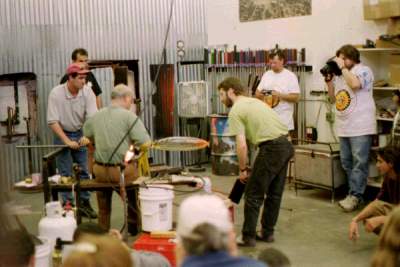 Extend the shape and swing to create a 2 foot long, 4"
diameter shape with lines curved down its length.
Extend the shape and swing to create a 2 foot long, 4"
diameter shape with lines curved down its length.
Flatten sides with thick dry cork blocks.
Punty to end, heat and pull neck to form a tube, snapping off
extra.
Pull on tube to refine shape of neck to graceful shape.
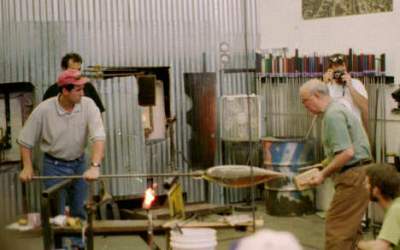 Heat and shape body with cork blocks again to an acute triangle
with rounded corners with the curved lines highlighting the shape.
Heat and shape body with cork blocks again to an acute triangle
with rounded corners with the curved lines highlighting the shape.
Take off the punty, torch the punty mark and put in the annealer.
WILLIAM MORRIS talked about his art
and methods at a well attended session. He is making more complex
shapes of his artifacts that suggest old bones and pottery of
some ancient people. He credits his team to the success in making
them. He rents Pilchuck from late September through April. Among
the equipment he considers helpful is a very well controlled
garage, a lot of torches (7) from large to small, an "arsenal
of tools" many made for a purpose and kept, many texture
plates that permit patterns that effect the picking up of color
powder. The pieces are so time consuming, he doesn't even
consider knocking them off the punty, but cuts them off with a
welding torch. There is a lot of coldwork to clean them afterward.
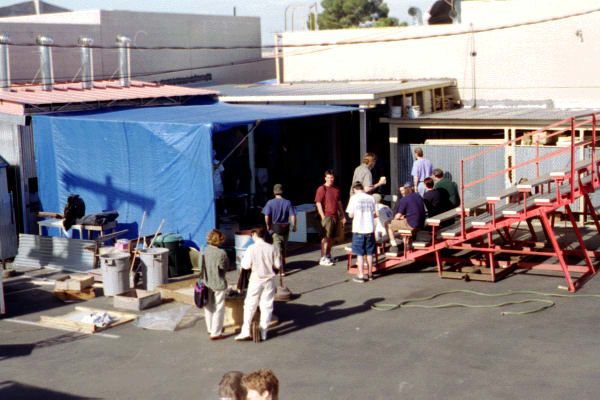 PHILABAUM'S is a pivot of hot glass
in Arizona - virtually everyone you talk to has blown there or
learned there or worked there. Located not far from downtown
Tucson (I walked it ... once) the site fronted with a sculpture
made from the tail of a C-131 and a building with a substantial
gallery and a large blowing studio.
PHILABAUM'S is a pivot of hot glass
in Arizona - virtually everyone you talk to has blown there or
learned there or worked there. Located not far from downtown
Tucson (I walked it ... once) the site fronted with a sculpture
made from the tail of a C-131 and a building with a substantial
gallery and a large blowing studio.
For the conference the
parking lot and part of the back of the building were transformed.
A complete outdoor setup (to remain after the conference) was
built along one wall and spaces provided for two lampworkers.
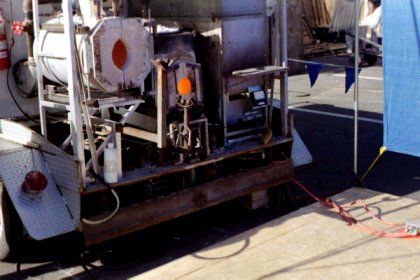 The
Southern Illinois University Mobile Glassblowing Trailer (Gladys)
was set up along the back edge with its own set of bleachers.
Several tents provided space for beadmakers and food and t-shirt
venders.
The
Southern Illinois University Mobile Glassblowing Trailer (Gladys)
was set up along the back edge with its own set of bleachers.
Several tents provided space for beadmakers and food and t-shirt
venders.
The hottest stars were scheduled in the main studio in two
sessions by ticket admission only. The other sites had good
people. Conference fees included a pair of visits to the site,
the choice made at registration often on the basis of the star
turn. I saw Lino and Stephen Powell during my time slots inside
and outside saw Bob Carlson.
Carlson did a blown piece into a sand mold, gathering clear
over the largest core I have ever seen put in a furnace. I have
always argued that most furnace doors are too big for the work
done through them. This is one case not. The core was about 6-7"
across and two gathers were done on top of that. The result was a
cube of nearly solid glass with faces and figures on each side
and a top blown out to a shape like the top of a minaret.
DESERT FIRE GLASSWORKS - [4 Cameno
Otero, Tubac AZ 85646, 520-398-8050] is located in a village of
arts and crafts that has been built next to a state park site of
old buildings including a church. What is oddest about it is that
it is miles and miles from almost everything, on the road between
Tucson and Nogales. The site is laid out like a small village,
but everything in the village is a shop for some art or craft or
a restaurant.
Desert Fire shares a building with AuSi Gallery [520-398-3193]
which is all glass from a number of artists. The studio got hot
in December. It is a nicely laid out standard studio with the
exception of an incredibly quiet furnace and a generator out back
to keep the glass going when the power fails (frequently I am
told.) Special steps were taken to keep the studio quiet and
until Allen Anderson, my guide, mentioned it, I had assumed the
studio was cold. In the gallery were a lot of nice pieces.
MAKE IT? - Richard Hornby makes a
business card holder in glass. His looks cast. His shape is about
the same as you would get by pressing clay into your palm and
into the cracks between your fingers, pressing a V above the palm
to hold the cards. It has a nice shape that sits pleasantly in
hand. It seems to me that an office desk or front desk would have
much more use for a card holder than a paperweight.
Subject: PLEASE HELP!!!!!!!! From: jr4reform@aol.com (Jr4reform)
Date: 19 Apr 1997 06:02:05 GMT I love the art of glass and any
application that deals with glass I'm eager to learn. When I
found a school that specialized in the craft...from painting,
fusing, slumping and stained, I was ecstatic. The Appalachian
Center for Arts and Crafts houses a 5000 square foot studio for
glasswork alone, and they have other programs for fiber working,
pottery, blacksmithing and numerous other crafts with talented
professors to guide you through the learning process. The problem
is the school that supports this program, Tennessee Technological
University wants to cut funding and possibly close the Center.
Please help the Appalachian Center for Arts and Crafts in their
letter writing campaign to keep the school open. Not only does
the Center offer college classes for those seeking a specialized
fine arts degree, but summer workshops for the whole family. This
Center is a community asset and must be kept alive!!!! Enclosed
is a number of e-mail addresses to write just to tell them how
important this school is to the future crafters of America. Dr.
Angelo Volpe, President of Tennessee Tech aav7268@tntech.edu Governor
Don Sunquist dsundquist@mail.state.tn.us
Dr. Charles Smith, Chancellor of TN Board of Regents csmith@tbr.state.tn.us
WIRING - The ground has just about
settled from all my trenching in the backyard and the temporary
rye grass is shooting up and down to hold the dirt in place. Last
night I finished the inside conduit installation and wiring of
the breakers and tonight I put in place the an outlet on the far
end of the wiring and flipped a breaker. I am still a ways from
getting the outside 40 amp service finished, since I only vaguely
know I am going to have standard outlets, a 220 outlet and
capacity for permanent wiring. I am further along in the garage,
with the old 6 breaker box that used to serve the house to handle
that end of the second 40 amp circuit. When I moved in, the whole
house was served on two breakers through 2 wire tube and post
wiring. Now I have 200 amp service with 3 wire 20 amp wiring
throughout, all of which I did after passing a homeowner test the
City of Dallas gives.4/30/97
HOW TO DESIGN YOUR CAREER PATH - is
seminar Sept. 12-14 at the Mt. Washington Conference Center,
Baltimore MD with a deadline of 7/31/97 for reduced registration
fee. "For craftspeople, students, and recent graduates who
want to learn how to craft a successful career." Experts in
more than a dozen topics. Product development, pricing, public
relations, etc. $299 for day participants, $399 for sessions,
meals, social events, and lodging. Scholarships available. The
Rosen Group, 3000 Chestnut Avenue, Suite 300, Baltimore MD 21211,
410-889- 2933, 1-800-43- CRAFT. 5/8/97
SOURCES - A web page that includes
samples of lampworked glass, links to other glass related pages
and a fairly good list of sources is http://www.teleport.com/~zoron/sources.html.
5/15/97
GLASSBLOWER WANTED From: "Bert
Weiss" Date: Mon, 12 May 1997 I'm posting this for Chris
Heilman Studio fine art glass studio and gallery needs all around
studio worker. Assist in one of a kind and limited edition
production. Also make and sell your own work in gallery. Must be
able to blow off hand glass products on your own. Great
opportunity and work environment. Chris Heilman Studio Art Glass
Portland Maine 207-854-1597
BOOKS.COM [Whitehouse-BOOKS.COM, 90
West Market St., Corning NY 14830, incorporating The Book
Exchange, 1-800-935-8536 FAX: 1-607-936-2465] a new name for one
of the better places to get older books on glass. 5/17/97
HANDS-ON GLASS [261 North Baker
Street, Corning NY 14830, 607-962-3044] 1997 Summer Programs
include weeklong and weekend classes. Weeklong Classes include
Beginning Glassblowing (July 7-11 and 21-25), Advanced Beginner (July
28-Aug.1), and Flame & Furnace (July 14-18) as well as
Sandcasting and Engraving. Weekend classes include Murrini at the
furnace (July 12-13) and two sessions of Beadmaking. The cost is
$350 to $485 for the week long and $185 for the furnace weekend.
If I could, the combination I would do is the Murrini weekend
followed by the Flame & Furnace week a combination costing $670.
The weekend instructors are Gretchen Lapp Hamlin, a blown glass
beadmaker, and Peter Secrest, who blows and kiln works, while
doing the week are Loren Stump, nationally known bead/flame worker,
and David Buck, Steuben Glass trained co-founder of Hands-on and
Studio Tech at The Studio of the Corning Museum. 5/17/97
FRABEL - which makes lampworked pieces of
modest size at $70-$300 (mostly, a full bouquet 34" tall is
$2,500 by special order) reminds me that the Gallery at Lenox
Square has been closed/moved to the studio. [Frabel, 695 Antone
St, NW, Atlanta GA 30318-7601, 1-800-843-1450, FAX: 404-351-1491,
http://www.frabel.com, studio@frabel.com] 5/19/97
CREATIVE GLASS CENTER OF AMERICA -
fellowships for 1998 has an application deadline of 9/2/97 for
three sessions Jan 5 - Apr 3, Apr 13 - July 10, Sep 14 - Dec 11,
1998. The Center is one prime gems of glass working careers,
giving unlimited access to glass for 3 months with housing and a
$1,500 monthly stipend provided. Application requires 10 labeled
slides or work and thirteen copies of the slide information
sheet, application, resume, statement of use of the period, two
letters of recommendation, one paragraph about you and work for
publicity purposes. Obligations include working in the view of
visitors 12 hours a week (not demoing, just working), donating a
piece, maintaining the house - cooking and cleaning. Equipment
includes a 750# clear and a 300# color tank, 9 kiln/annealers, 2
glory holes, 2 benches, lampworking station, 9 extremely serious
pieces of coldworking equipment, sandblasting, engraving, and
electroplating equipment. [Creative Glass Center of America,
Wheaton Village, 1501 Glasstown Road, Millville NJ 08332-1566,
609-825-6800 x 2733, FAX: 609-825- 2410] 5/19/97
C.E.R.F. is worthy of your attention and
donations, since it provides funds for craft artists who are
stricken by disaster - whether that means a car stolen with all
tools and latest work or a flood, earthquake or fire devastating
the studio. [Cornelia Carey, Exec.Dir., CERF (Craft Emergency
Relief Fund), P.O.Box 838, Montpelier VT 05601, 802-229-2306, FAX:
802-223-6484] 5/19/97 Thirty-eight galleries around the U.S. have
joined in naming September 1997 A MONTH FOR CERF Galleries
include two in Texas (as of 9 June) Two Friends Gallery in
Galveston and Hanson Galleries in Houston. Other states
represented include MA, NY, CO, OH, NC, CT, MO, CA, AR, NM MI,
OR, and VT. 7/6/97
ANNEALING KILN - Subj: Re:
Annealing Kiln Date: 97-06-05 19:32:52 EDT From: cogen@ll.mit.edu
(David Cogen)
Hi, a couple months ago you gave me some advice for my annealing
kiln I was building. (I do respond to mail, but it takes a while!)
You discouraged me from using a light dimmer as a manual
controller. I took that advice and ended up getting a 76000
controller from Omega Engineering. This is an excellent
controller, with a single segment ramp/soak, for about $200. Of
course, some work was required to use this controller: add an
enclosure, an external relay, outlet, switches, etc. But I am
quite pleased with the results.
I splurged and got the RS-485 communication option ($50 more).
Someday I will connect the controller to my Macintosh and then I
can do any temperature profile I can imagine, by writing a
program on the Mac to control the controller. But for my purposes
at present (glass beads), I imaging the single segment ramp-down
(or even natural cooling in the oven) will be sufficient. Thanks
for the advice. -- David Cogen -- Scarabe Subject: Two Glass
Blowing Studios open in AZ From: rowenaaest@aol.com (RowenaAest)
Date: 8 Jun 1997 13:29:06 GMT This summer AZ will grow in
greatness. Two Glass Blowing Studios will open. One in Glendale.......Don
McKinney will be moving his Glass Blowing into a building next to
The Glass Palette Gallery and Jim Antionius opens his new
addition in Prescott. Glass is Growing in Arizona!.........Rowena
Texas Lamp Manufacturing, 505 East Highway 80 Forney Texas 75126,
972-552- 2602 has a catalog and an extraordinary selection of
parts, shades, bases, etc.
Subj: No Subject Date: 97-06-10 16:32:15 EDT From: hultman@ix.netcom.com
(Lori or Jeff Hultman) To: MikeFirth
Hi Mike--
I haven't heard from you in awhile, not since I told you about
my experience at Corning in Jan of this year. What's new? Also,
issue 35 of Hot Glass Bits is the last one I received--have
you not done any since then?
I still haven't built my hot shop. Now money is a problem--but
I remain ever optimistic. I returned to Corning for Paul
Stankard's class (lampworking) and it was a pretty good class.
Also teaching were Lino Tagliapietra and Donna Milliron. So the
entire experience was extraordinary. Watching Lino work is
fantastic (not to mention a little depressing, knowing I'll never
be able to do anything like what he does).
Still, he is such a master and such a sweet person as well.
He's also a great cook and made dinner for the whole group (about
35 people) one night during the class. He took over the
restaurant at the Day's Inn where Corning has us stay. Anyway,
what's up with you and what's up with Hot Glass Bits? I
miss you both. Lori Hultman
The Corning experience sounds grand. Lino is nice and I had
wondered whether you got the chance to share between classes.
Thanks for letting me know.
When I took the class at GAS 93, Bowling Green State U., I was
the least experienced person there by far. Most had owned or now
owned their own shops. I was asked by one of the hosts whether I
found watching more experienced people depressing, and my
response was NO!!, I found it exhilarating. I have a long set of
notes on watching Lino at GAS and the lessons I drew from it. I
don't know that I would be able to do what he does (I probably
won't but I don't KNOW it) and the pieces I learn, just like the
"mistakes" that are interesting while I am learning,
seem part of the challenge.
Just as I am delayed with HB36, I continue to plod with the
furnace. I have worked on the wiring outside in parallel with the
more necessary garage work and have cut the tube for the flue
Subject: Kiln Controller From: jh@ihug.co.nz (HH) Date: Wed,
02 Jul 1997 09:35:35 GMT Who knows a good and reliable
temperature controller for cone 10 firings. Requires at least six
steps to fire my four burner gas kiln.
Subject: Re: Kiln Controller From: Roger Peterson rlpete@ix.netcom.com
Date: Fri,04 Jul 1997 HH, Go to the Watlow home page; http://www.watlow.com/
Look into their 981/982 controller. It has four 6-step ramp
programs, hi/low alarms, etc. etc. I saw on in action at Brian
Kerkvliet's a few weeks ago and was impresses enough to put one
on order. ($425 for the options I wanted to run a glass annealing
kiln.)
If you have a FAX, get the page that lists their FAX-back 800-number
and dial for a spec sheet. Then call the nearest Watlow office to
get the name of their local distributer. I ordered 7 days ago and
expect it early next week. Roger...
COLOR ROD SALE - Olympic Color Rods [818
John St., Seattle WA 98109, 1-800-445- 7742, 206-343-7336 Fax 888-880-rods
or 206-243-2292] is offering 20% off on Kugler, Reichenbach, and
Zimmerman colored Rod, Powder and Frit in specific colors,
limited to the stock on hand (no special orders) until July 31. 7/6/97
RICHARDS AWARD FOR RESEARCH IN AMERICAN GLASS to be presented annually. A
total of $10,000 has been made available for 1998 for assistance
in meeting research project costs, including travel, living
expenses, and photography and publication expenses for
collectors, scholars, students, and institutions for original
research related to the manufacture, distribution, sale, or use
of glass in the American market during the 17th-19th centuries.
Deadline 1 Feb. 98. Applications are available from the Corning
Museum of Glass [One Museum Way, Corning NY 14830-2253] or the
Richards Foundation, P.O.Box 39, Portsmouth RI 02871 7/6/97
THE INDEPENDENT GLASSBLOWER TAKES A
BREAK. IGB is moving and suspending publication for 6 months from
June 20th. The new address effective that date is David Gruenig,
RFD #2 Box 238-B, Lyndonville VT 05851. No electricity, etc.,
available, although back issues are. Write with notes & hints.
7/6/97
TOOTS ZYNSKY has a nice interview in Glass Focus [Beverly
Copeland, Glass Focus, the Contemporary Art Glass Periodical,
Glass in Black & White, 9323 Olcott, Morton Grove IL 60053,
708-967-8433, $28/yr] touching on the early days of Pilchuck and
exploring how she began doing her distinctive fused filament
glass sculptures. Glass Focus is primarily for collectors, but
the listings of showings and events can be useful for glass
workers and the interviews have been interesting. 7/6/97
1998 GAS Conference will be in Seto,
Japan, May 38-31. Plans still being worked on will try to permit
as many people as possible to go at a cost close to commercial
travel at a stateside site. Glass Art Society, 1305 4th Avenue,
Suite 711, Seattle WA 98101-3401. 7/6/97
Blow Good Glass Hot Glass in Texas Dallas - Kittrell-Riffkind
Art Glass, [5100 Beltline Suite, Suite 820, 214- 239-7957] July
11- August 9th - Goblet Invitational. Dallas: Carlyn Galerie, [6137
Luther Lane, 214-368-2828]
In Wimberley, southwest of Austin, Sable V Fine Art Gallery, [The
Courtyard Overlooking Cypress Creek, 512-847-8975] The Art of
Children will include work by artists under 18, including Alex
Mack, 9 years old, who works in flat glass doing sculptures and
wall hangings. The 5th annual Gathering of Glass will open
September 20th and artists who are interested are invited to send
slides. Gathering includes all forms of glass work.
The MSC Forsyth Center Galleries [Student Center, Texas
A&M University, College Station, 409-845-9251]
1 In this space are pasted ads containing the following text.
2 Joppa Glassworks, Inc., We make and sell annealing kiln
elements and Giberson Ceramic
3 Burner Heads for your gloryholes and furnaces. For ideas on how
to improve your studio equipment
4 call or write Dudley Giberson, Warner NH 03278, 603-456-3569
fax:456-2138
5 ------------
6 Divas Glass Art, Terry Maxwell, Shirley Daniel, Classes, Pipes,
and Blocks
7 1100 East Rendon-Crowley Road, Building #7, Burleson TX 76028,
(817) 293- 0190
8 Fax:(817) 293-9565
1 In this space are pasted ads containing the following
2 Gabbert Cullet Company, Dealer in Glass Cullet,
3 Frank G. Lane, Owner, 700 Cherry Avenue,
4 Williamstown WV 26187 304-375-6435 Office
5 ---- 304-375-7790 Home; FAX:304-375-4832
6 DIAMOND DISKS - nickel plated and resin
GRINDING/POLISHING SUPPLIES
7 punty grinding wheels, perfume reamers belts (diamon, sil carb,
cork) sawblades.
8 Parts and pads for dremel, cerium oxide, etc. Call for catalog
of kiamond grinding and polishing
9 supplies HIS GLASSWORKS INC, 91 Webb Cove Road, Asheville NC
28804
10 Phone 800/914-7463 fax 704-254-2581 For your convenience, the
form below is printed opposite the mailing label on the back
page, so you can cut it out to renew, etc. and leave the
information intact. I send Hot Glass Bits to: Those who
are mentioned in an issue, Hot Glass Texans, others I feel like
sending a copy to, and those who have paid for it.
 LINO TAGLIAPIETRA blew two
demonstrations on Saturday morning, a hot ticket that caused some
problems with people who had registered very early in expectation
of being certain of getting in. I saw the first demo. Within the
limits of my notes and memory, this is what he did. [2003 - I don't have
pictures of the early part of the demo because the film was slipping in my
camera, making a multiple image.]
LINO TAGLIAPIETRA blew two
demonstrations on Saturday morning, a hot ticket that caused some
problems with people who had registered very early in expectation
of being certain of getting in. I saw the first demo. Within the
limits of my notes and memory, this is what he did. [2003 - I don't have
pictures of the early part of the demo because the film was slipping in my
camera, making a multiple image.]






